Hyeonsu Lyu
Fed-ZOE: Communication-Efficient Over-the-Air Federated Learning via Zeroth-Order Estimation
Dec 21, 2024Abstract:As 6G and beyond networks grow increasingly complex and interconnected, federated learning (FL) emerges as an indispensable paradigm for securely and efficiently leveraging decentralized edge data for AI. By virtue of the superposition property of communication signals, over-the-air FL (OtA-FL) achieves constant communication overhead irrespective of the number of edge devices (EDs). However, training neural networks over the air still incurs substantial communication costs, as the number of transmitted symbols equals the number of trainable parameters. To alleviate this issue, the most straightforward approach is to reduce the number of transmitted symbols by 1) gradient compression and 2) gradient sparsification. Unfortunately, these methods are incompatible with OtA-FL due to the loss of its superposition property. In this work, we introduce federated zeroth-order estimation (Fed-ZOE), an efficient framework inspired by the randomized gradient estimator (RGE) commonly used in zeroth-order optimization (ZOO). In FedZOE, EDs perform local weight updates as in standard FL, but instead of transmitting full gradient vectors, they send compressed local model update vectors in the form of several scalar-valued inner products between the local model update vectors and random vectors. These scalar values enable the parameter server (PS) to reconstruct the gradient using the RGE trick with highly reduced overhead, as well as preserving the superposition property. Unlike conventional ZOO leveraging RGE for step-wise gradient descent, Fed-ZOE compresses local model update vectors before transmission, thereby achieving higher accuracy and computational efficiency. Numerical evaluations using ResNet-18 on datasets such as CIFAR-10, TinyImageNet, SVHN, CIFAR-100, and Brain-CT demonstrate that Fed-ZOE achieves performance comparable to Fed-OtA while drastically reducing communication costs.
Replace-then-Perturb: Targeted Adversarial Attacks With Visual Reasoning for Vision-Language Models
Nov 01, 2024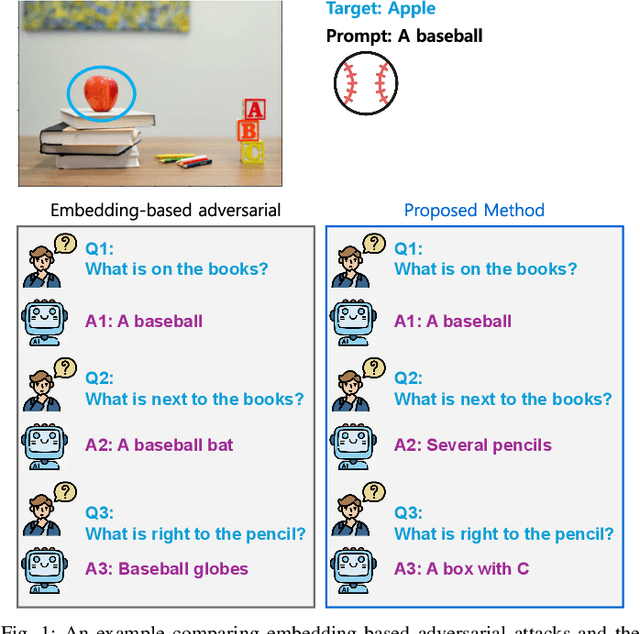

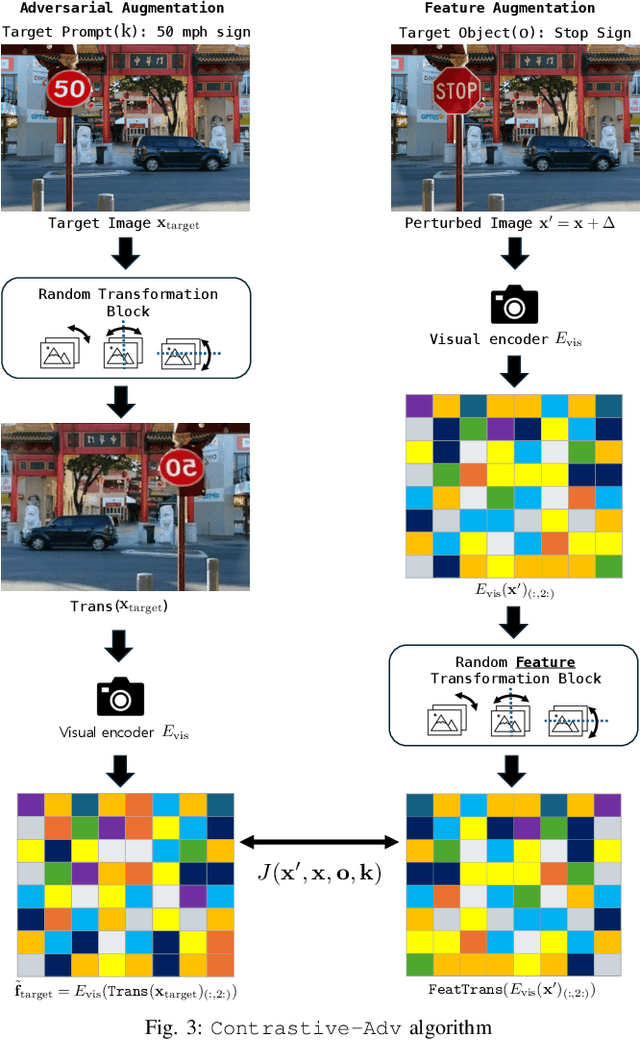
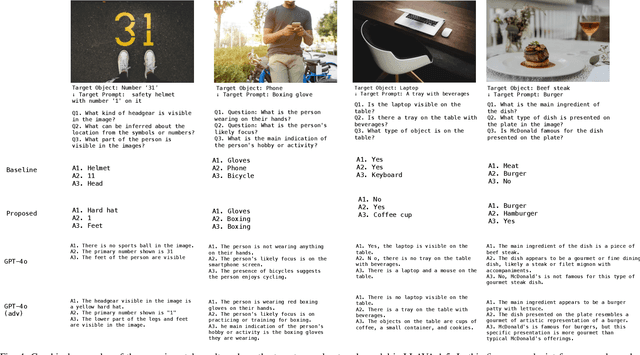
Abstract:The conventional targeted adversarial attacks add a small perturbation to an image to make neural network models estimate the image as a predefined target class, even if it is not the correct target class. Recently, for visual-language models (VLMs), the focus of targeted adversarial attacks is to generate a perturbation that makes VLMs answer intended target text outputs. For example, they aim to make a small perturbation on an image to make VLMs' answers change from "there is an apple" to "there is a baseball." However, answering just intended text outputs is insufficient for tricky questions like "if there is a baseball, tell me what is below it." This is because the target of the adversarial attacks does not consider the overall integrity of the original image, thereby leading to a lack of visual reasoning. In this work, we focus on generating targeted adversarial examples with visual reasoning against VLMs. To this end, we propose 1) a novel adversarial attack procedure -- namely, Replace-then-Perturb and 2) a contrastive learning-based adversarial loss -- namely, Contrastive-Adv. In Replace-then-Perturb, we first leverage a text-guided segmentation model to find the target object in the image. Then, we get rid of the target object and inpaint the empty space with the desired prompt. By doing this, we can generate a target image corresponding to the desired prompt, while maintaining the overall integrity of the original image. Furthermore, in Contrastive-Adv, we design a novel loss function to obtain better adversarial examples. Our extensive benchmark results demonstrate that Replace-then-Perturb and Contrastive-Adv outperform the baseline adversarial attack algorithms. We note that the source code to reproduce the results will be available.
Unveiling Hidden Visual Information: A Reconstruction Attack Against Adversarial Visual Information Hiding
Aug 08, 2024Abstract:This paper investigates the security vulnerabilities of adversarial-example-based image encryption by executing data reconstruction (DR) attacks on encrypted images. A representative image encryption method is the adversarial visual information hiding (AVIH), which uses type-I adversarial example training to protect gallery datasets used in image recognition tasks. In the AVIH method, the type-I adversarial example approach creates images that appear completely different but are still recognized by machines as the original ones. Additionally, the AVIH method can restore encrypted images to their original forms using a predefined private key generative model. For the best security, assigning a unique key to each image is recommended; however, storage limitations may necessitate some images sharing the same key model. This raises a crucial security question for AVIH: How many images can safely share the same key model without being compromised by a DR attack? To address this question, we introduce a dual-strategy DR attack against the AVIH encryption method by incorporating (1) generative-adversarial loss and (2) augmented identity loss, which prevent DR from overfitting -- an issue akin to that in machine learning. Our numerical results validate this approach through image recognition and re-identification benchmarks, demonstrating that our strategy can significantly enhance the quality of reconstructed images, thereby requiring fewer key-sharing encrypted images. Our source code to reproduce our results will be available soon.
Non-iterative Optimization of Trajectory and Radio Resource for Aerial Network
May 02, 2024Abstract:We address a joint trajectory planning, user association, resource allocation, and power control problem to maximize proportional fairness in the aerial IoT network, considering practical end-to-end quality-of-service (QoS) and communication schedules. Though the problem is rather ancient, apart from the fact that the previous approaches have never considered user- and time-specific QoS, we point out a prevalent mistake in coordinate optimization approaches adopted by the majority of the literature. Coordinate optimization approaches, which repetitively optimize radio resources for a fixed trajectory and vice versa, generally converge to local optima when all variables are differentiable. However, these methods often stagnate at a non-stationary point, significantly degrading the network utility in mixed-integer problems such as joint trajectory and radio resource optimization. We detour this problem by converting the formulated problem into the Markov decision process (MDP). Exploiting the beneficial characteristics of the MDP, we design a non-iterative framework that cooperatively optimizes trajectory and radio resources without initial trajectory choice. The proposed framework can incorporate various trajectory planning algorithms such as the genetic algorithm, tree search, and reinforcement learning. Extensive comparisons with diverse baselines verify that the proposed framework significantly outperforms the state-of-the-art method, nearly achieving the global optimum. Our implementation code is available at https://github.com/hslyu/dbspf.
Patch-MI: Enhancing Model Inversion Attacks via Patch-Based Reconstruction
Dec 12, 2023

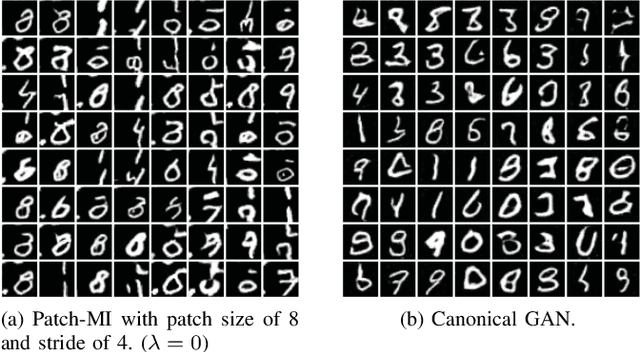
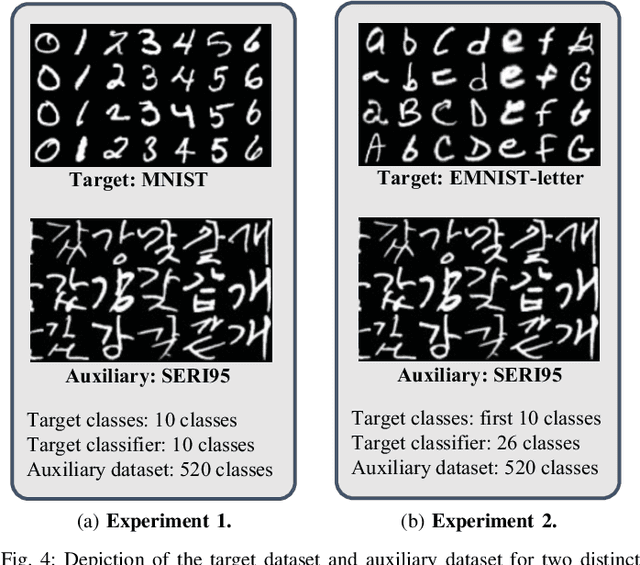
Abstract:Model inversion (MI) attacks aim to reveal sensitive information in training datasets by solely accessing model weights. Generative MI attacks, a prominent strand in this field, utilize auxiliary datasets to recreate target data attributes, restricting the images to remain photo-realistic, but their success often depends on the similarity between auxiliary and target datasets. If the distributions are dissimilar, existing MI attack attempts frequently fail, yielding unrealistic or target-unrelated results. In response to these challenges, we introduce a groundbreaking approach named Patch-MI, inspired by jigsaw puzzle assembly. To this end, we build upon a new probabilistic interpretation of MI attacks, employing a generative adversarial network (GAN)-like framework with a patch-based discriminator. This approach allows the synthesis of images that are similar to the target dataset distribution, even in cases of dissimilar auxiliary dataset distribution. Moreover, we artfully employ a random transformation block, a sophisticated maneuver that crafts generalized images, thus enhancing the efficacy of the target classifier. Our numerical and graphical findings demonstrate that Patch-MI surpasses existing generative MI methods in terms of accuracy, marking significant advancements while preserving comparable statistical dataset quality. For reproducibility of our results, we make our source code publicly available in https://github.com/jonggyujang0123/Patch-Attack.
Deeper Understanding of Black-box Predictions via Generalized Influence Functions
Dec 09, 2023Abstract:Influence functions (IFs) elucidate how learning data affects model behavior. However, growing non-convexity and the number of parameters in modern large-scale models lead to imprecise influence approximation and instability in computations. We highly suspect that the first-order approximation in large models causes such fragility, as IFs change all parameters including possibly nuisance parameters that are irrelevant to the examined data. Thus, we attempt to selectively analyze parameters associated with the data. However, simply computing influence from the chosen parameters can be misleading, as it fails to nullify the subliminal impact of unselected parameters. Our approach introduces generalized IFs, precisely estimating target parameters' influence while considering fixed parameters' effects. Unlike the classic IFs, we newly adopt a method to identify pertinent target parameters closely associated with the analyzed data. Furthermore, we tackle computational instability with a robust inverse-Hessian-vector product approximation. Remarkably, the proposed approximation algorithm guarantees convergence regardless of the network configurations. We evaluated our approach on ResNet-18 and VGG-11 for class removal and backdoor model recovery. Modifying just 10\% of the network yields results comparable to the network retrained from scratch. Aligned with our first guess, we also confirm that modifying an excessive number of parameters results in a decline in network utility. We believe our proposal can become a versatile tool for model analysis across various AI domains, appealing to both specialists and general readers. Codes are available at https://github.com/hslyu/GIF.
Privacy-Protection Drone Patrol System based on Face Anonymization
May 29, 2020



Abstract:The robot market has been growing significantly and is expected to become 1.5 times larger in 2024 than what it was in 2019. Robots have attracted attention of security companies thanks to their mobility. These days, for security robots, unmanned aerial vehicles (UAVs) have quickly emerged by highlighting their advantage: they can even go to any hazardous place that humans cannot access. For UAVs, Drone has been a representative model and has several merits to consist of various sensors such as high-resolution cameras. Therefore, Drone is the most suitable as a mobile surveillance robot. These attractive advantages such as high-resolution cameras and mobility can be a double-edged sword, i.e., privacy infringement. Surveillance drones take videos with high-resolution to fulfill their role, however, those contain a lot of privacy sensitive information. The indiscriminate shooting is a critical issue for those who are very reluctant to be exposed. To tackle the privacy infringement, this work proposes face-anonymizing drone patrol system. In this system, one person's face in a video is transformed into a different face with facial components maintained. To construct our privacy-preserving system, we have adopted the latest generative adversarial networks frameworks and have some modifications on losses of those frameworks. Our face-anonymzing approach is evaluated with various public face-image and video dataset. Moreover, our system is evaluated with a customized drone consisting of a high-resolution camera, a companion computer, and a drone control computer. Finally, we confirm that our system can protect privacy sensitive information with our face-anonymzing algorithm while preserving the performance of robot perception, i.e., simultaneous localization and mapping.
 Add to Chrome
Add to Chrome Add to Firefox
Add to Firefox Add to Edge
Add to Edge